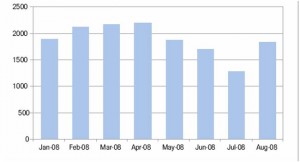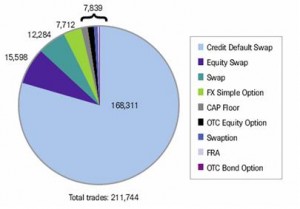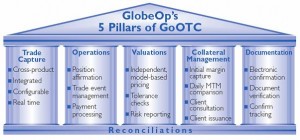This past week and a half has proven to be a busy time for the CFTC’s enforcement divisions as a number of actions have been released to the public. The four actions below showcase the unlawful and unsavory behavior of four groups. Specifically, two of the actions below provide details of two more Ponzi schemes and the other two actions involve misrepresentations and lies. As we’ve discussed before hedge fund investors have many tools to protect themselves from these sorts of actions. Simple hedge fund due diligence will go a long way towards protecting an investment.
****
Release: 5612-09
For Release: February 11, 2009
CFTC Orders Former Bank Trader and New York City Resident to Pay $360,000 Penalty in Connection with False Trading Reports Submitted to His Former Employer, Bank of America
Washington, DC — The U.S. Commodity Futures Trading Commission (CFTC) today settled charges against Michael Moster for submitting false reports to the Bank of America in Chicago, where he once worked as a trader, and ordered Moster to pay a $360,000 civil penalty.
The CFTC issued an order on February 11, 2009, which finds that, during a three-day period in January 2004, Moster, a former proprietary trader for the Bank of America, falsely reported to the bank that he purchased 4,000 Treasury futures contracts to conceal the risk associated with large unauthorized positions in Treasury bonds that he established over the same time period, by making it appear as if the long futures position hedged the Treasury bond risk. By the following week, the fictitious trades inflated the value of his trading book by over $12 million, the order finds. The sale of Moster’s unauthorized Treasury bond position resulted in a loss of approximately $12.2 million to the Bank of America.
Based upon the same conduct, Moster pled guilty on September 18, 2008, to a one-count violation of making false entry into the books and records of a bank in the Southern District of New York. Under the criminal sentencing guidelines, Moster will be required to make full restitution of the over $12 million loss he caused to the Bank of America. The CFTC’s order recognizes the restitution made in the context of the criminal case and provides that Moster must pay and satisfy any criminal restitution obligation before his payment of the CFTC civil monetary penalty.
The following CFTC Division of Enforcement staff members are responsible for this case: Ken Koh, Todd Kelly, Peter Haas, Paul Hayeck, and Joan Manley.
****
Release: 5610-09
For Release: February 10, 2009
CFTC Seeks Freeze of Assets in Oklahoma Ponzi Scheme Involving Over $30 Million
Mark Trimble of Edmond, Oklahoma Posted Profits, While Losing Millions in Phidippides Capital Hedge Fund
Washington, DC – The Commodity Futures Trading Commission (CFTC) announced that today it filed an enforcement action against Mark S. Trimble, of Edmond, Oklahoma, and his company, Phidippides Capital Management LLC (PCM), with offices in Oklahoma City. Trimble, who controlled Phidippides, also managed a private hedge fund named Phidippides Capital LP, which the CFTC’s complaint alleges was a Ponzi scheme.
CFTC Seeks Court Order Freezing Defendants’ Assets
In conjunction with the filing of the complaint today in the U.S. District Court for the Western District of Oklahoma, the CFTC is seeking a statutory restraining order freezing defendants’ assets and preserving records. Trimble has consented to the entry of an asset freeze order.
The CFTC’s complaint alleges that, from at least 2005 to the present, Trimble and PCM operated a $34 million hedge fund with approximately 60 investors and traded partly in the name of Phidippides Capital, a Delaware company incorporated by Trimble. Since at least October 2007, Trimble and PCM allegedly issued false account statements, failed to disclose the fund’s actual multi-million trading losses, and operated the fund as a Ponzi scheme, paying participant redemptions based on the fund’s fabricated profitability. Additionally, defendants allegedly received over $1 million in management fees based on false reports of trading profits.
Trimble Used Email to Notify Investors that He Had Not Been “Honest” About the Fund’s Trading Results
According to the complaint, Trimble’s activities were exposed in late January 2009, after Trimble provided the Federal Bureau of Investigation a fictitious 2008 year-end trading account showing millions of dollars in trading profits that did not square with actual trading statements issued by Trimble’s brokerage firm that disclosed millions of dollars in trading losses. Trimble subsequently stated in an email sent to his brokerage firm, and addressed to “Family, Friends, and Clients,” that he had not been “honest” about the hedge fund’s trading results, explaining: “The reason our balances are off is because I could not look myself in the mirror and face all of you and notify you that in the last quarter of 2008 we lost all the profits for the year and then some.”
Stephen J. Obie, CFTC Acting Director of the Division of Enforcement commented: “Through the swift action of CFTC staff, millions of dollars have been frozen, which ultimately we will seek to return to the victims Trimble deceived by his scheme. The CFTC continues to zealously prosecute these lecherous schemes, so that as many assets can be preserved as possible as we fulfill our vital mission to protect customers from fraud and abuse.”
The CFTC’s complaint seeks civil monetary penalties, disgorgement of ill-gotten gains, restitution to defrauded customers, and injunctive relief, among other sanctions.
The CFTC appreciates the assistance of the Securities and Exchange Commission and the Financial Crimes Enforcement Network.
The following CFTC Division of Enforcement staff members are responsible for this case: Rosemary Hollinger, Scott Williamson, Richard Wagner, and Ken Hampton. CFTC Auditors Thomas J. Bloom, Shauna Wright-Regas, and Lauren Corn also are working on this matter.
****
Release: 5609-09
For Release: February 6, 2009
CFTC Obtains Judgment Against Albert E. Parish and Parish Economics LLC for Operating a Commodity Pool Scam in CFTC Anti-Fraud Action
Parish Currently Serving a Sentence of More than 24 years in Federal Prison for Related Criminal Violations
Washington, DC — The U.S. Commodity Futures Trading Commission (CFTC) announced today that the Honorable David C. Norton of the U.S. District Court for the District of South Carolina entered an order settling charges alleging that Albert E. Parish and Parish Economics LLC, both of Charleston, South Carolina, lied to customers and misappropriated millions of dollars in customer funds (see CFTC Press Release 5320-07, April 19, 2007).
According to the order entered on February 2, 2009, between 1986 and March 2007, Parish and Parish Economics fraudulently solicited approximately $40 million in investments for their commodity futures pool. Parish and Parish Economics misrepresented to pool participants that funds would be invested in commodity futures when, in reality, Parish misappropriated the vast majority of funds for his personal use. Parish and Parish Economics also provided false futures account statements to pool participants and failed to provide required pool disclosure documents.
The order permanently bars Parish and Parish Economics from further violating certain provisions of the Commodity Exchange Act and the CFTC’s regulations and from engaging in any commodity-related activity. Parish is currently serving a sentence of more than 24 years in federal prison for related criminal violations. In lieu of an award of restitution and civil monetary penalties, the order recognizes that Parish will be subject to a criminal judgment restitution obligation in excess of $40 million.
The CFTC would like to thank James A. Rue of the Securities and Exchange Commission and John H. Douglas of the U.S. Attorney’s Office for the District of South Carolina for their assistance in this matter.
The following CFTC Division of Enforcement staff members are responsible for this case: Jo Mettenburg, Jeff Le Riche, Charles Marvine, Donald Nash, Rick Glaser, and Richard Wagner.
****
Release: 5608-09
For Release: February 5, 2009
CFTC Charges Minnesota Resident Charles “Chuck” E. Hays and His Company, Crossfire Trading, LLC, with Running a $5.5 Million Ponzi Scheme
Washington, DC – The U.S. Commodity Futures Trading Commission (CFTC) filed an enforcement action today against Charles “Chuck” E. Hays and Crossfire Trading, LLC (Crossfire), both of Rosemount, Minnesota, charging them with fraud and misappropriation in connection with a commodity pool Ponzi scheme.
In conjunction with the filing of the complaint today in the U.S. District Court for the District of Minnesota, the CFTC is seeking a statutory restraining order freezing defendants’ assets and preserving records.
The CFTC’s complaint alleges that, from January 2006 to the present, Hays and his company, Crossfire, a purported commodity pool, fraudulently solicited and accepted more than $5.5 million from at least three individuals and a charitable foundation for the purpose of trading stock index and crude oil futures.
Hays, according to the complaint, convinced at least one person to invest in Crossfire by representing verbally and in fabricated account statements — issued on Crossfire’s letterhead — that Crossfire earned consistent profits trading commodity futures with no losing months. However, as charged in the complaint, Crossfire has never had an active commodity futures trading account. Additionally, in an attempt to alleviate at least two investors’ suspicions as to what Hays was actually doing with their money, Hays provided an account statement for the Crossfire pool fabricated to appear as if it were issued by a legitimate brokerage company by using that brokerage’s letterhead. This false account statement indicated that Crossfire maintained a trading account at the brokerage with over $37 million. As alleged, that account is nonexistent.
Furthermore, the complaint charges Hays with misappropriating investor funds to purchase a $4 million yacht, and for other purposes.
“Hays ran his Ponzi scheme from his yacht, but was grounded when the tide turned as Federal authorities exposed this egregious fraud,” said CFTC Acting Director of Enforcement Stephen J. Obie.
The CFTC complaint seeks orders requiring the defendants to provide the CFTC with continuing access to books and records and to make an accounting with information necessary to determine the actual amounts of net contributions and profits or losses. The CFTC also requests that the court issue orders of preliminary and permanent injunction against the defendants, a return of alleged ill-gotten gains, repayments to defrauded investors, monetary penalties, and other relief.
The CFTC appreciates the assistance of the United States Attorney’s Office for the District of Minnesota, the Department of Justice, the United States Postal Inspection Service, and the Federal Bureau of Investigation in this action. Hays was arrested this morning by Federal authorities.
The following CFTC Division of Enforcement staff is responsible for this case: Susan Gradman, Neville Hedley, Judith McCorkle, Venice Bickham, Scott Williamson, Rosemary Hollinger, and Richard Wagner.


